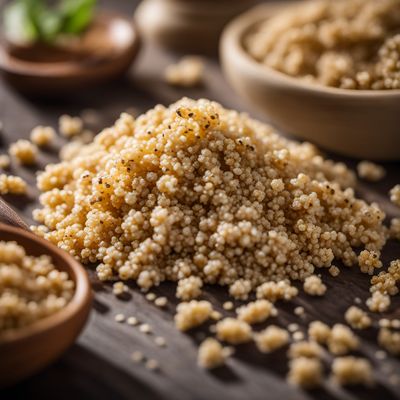
Ingredient
Buckwheat and other pseudo-cereals and similar-
Nutritious Grains: Unveiling the World of Buckwheat and Pseudo-Cereals
Buckwheat and other pseudo-cereals, such as quinoa and amaranth, are gluten-free grains that have a nutty and earthy flavor. They have a slightly chewy texture and can be cooked to be fluffy or creamy, depending on the desired outcome. These grains are often used as a substitute for traditional cereals and are a staple in many cuisines around the world.
Origins and history
Buckwheat, originating from Central Asia, has been cultivated for thousands of years and is a staple in cuisines like Russian, Japanese, and Eastern European. Quinoa, native to the Andean region of South America, was considered sacred by the Incas and has gained popularity worldwide for its nutritional value. Amaranth, an ancient grain cultivated by the Aztecs, is still widely consumed in Mexico and other parts of Central and South America.
Nutritional information
Buckwheat and other pseudo-cereals and similar grains are rich in fiber, protein, and essential minerals like magnesium, manganese, and phosphorus. They are also a good source of antioxidants and contain beneficial plant compounds. Additionally, they are naturally gluten-free, making them suitable for individuals with gluten sensitivities or celiac disease.
How to select
When selecting buckwheat and other pseudo-cereals, look for grains that are free from any signs of moisture or insect damage. Opt for whole grains rather than processed versions to retain their nutritional value. Additionally, consider purchasing organic varieties to minimize exposure to pesticides.
Storage recommendations
To maintain the freshness and quality of buckwheat and other pseudo-cereals, store them in airtight containers in a cool, dry place. This will help prevent them from becoming rancid or infested with pests. Cooked grains can be stored in the refrigerator for a few days.
How to produce
Buckwheat and other pseudo-cereals can be grown at home with proper care and suitable growing conditions. They thrive in well-drained soil and require regular watering. However, it is essential to research specific growing requirements for each grain to ensure successful cultivation.
Preparation tips
Buckwheat and other pseudo-cereals can be used in a variety of dishes, including salads, stir-fries, pilafs, porridges, and baked goods. They can be cooked as a standalone grain or combined with other ingredients to create flavorful and nutritious meals.
Culinary uses
Buckwheat and other pseudo-cereals are versatile ingredients used in cuisines worldwide. They are commonly found in dishes like buckwheat pancakes (blini), quinoa salads, amaranth porridge, and gluten-free baked goods. Their adaptability makes them a popular choice among individuals following gluten-free or plant-based diets.
Availability
Buckwheat is commonly cultivated in countries like Russia, China, Ukraine, and the United States. Quinoa is primarily grown in Bolivia, Peru, and Ecuador, while amaranth is cultivated in Mexico, Peru, and India.



